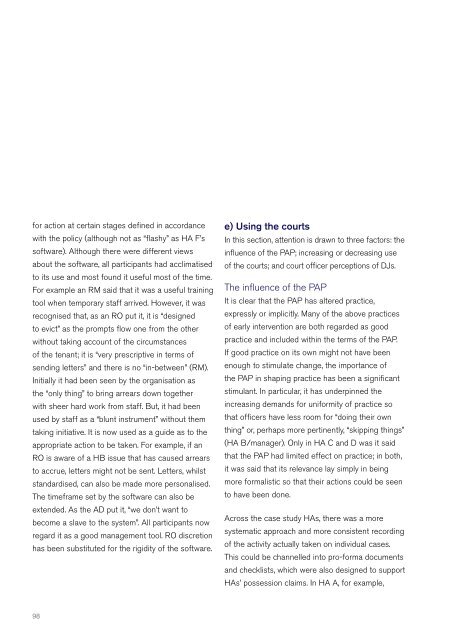Rent arrears management practices in the housing association sector
Rent arrears management practices in the housing association sector
Rent arrears management practices in the housing association sector
Create successful ePaper yourself
Turn your PDF publications into a flip-book with our unique Google optimized e-Paper software.
for action at certa<strong>in</strong> stages def<strong>in</strong>ed <strong>in</strong> accordance<br />
with <strong>the</strong> policy (although not as “flashy” as HA F’s<br />
software) . Although <strong>the</strong>re were different views<br />
about <strong>the</strong> software, all participants had acclimatised<br />
to its use and most found it useful most of <strong>the</strong> time .<br />
For example an RM said that it was a useful tra<strong>in</strong><strong>in</strong>g<br />
tool when temporary staff arrived . However, it was<br />
recognised that, as an RO put it, it is “designed<br />
to evict” as <strong>the</strong> prompts flow one from <strong>the</strong> o<strong>the</strong>r<br />
without tak<strong>in</strong>g account of <strong>the</strong> circumstances<br />
of <strong>the</strong> tenant; it is “very prescriptive <strong>in</strong> terms of<br />
send<strong>in</strong>g letters” and <strong>the</strong>re is no “<strong>in</strong>-between” (RM) .<br />
Initially it had been seen by <strong>the</strong> organisation as<br />
<strong>the</strong> “only th<strong>in</strong>g” to br<strong>in</strong>g <strong>arrears</strong> down toge<strong>the</strong>r<br />
with sheer hard work from staff . But, it had been<br />
used by staff as a “blunt <strong>in</strong>strument” without <strong>the</strong>m<br />
tak<strong>in</strong>g <strong>in</strong>itiative . It is now used as a guide as to <strong>the</strong><br />
appropriate action to be taken . For example, if an<br />
RO is aware of a HB issue that has caused <strong>arrears</strong><br />
to accrue, letters might not be sent . Letters, whilst<br />
standardised, can also be made more personalised .<br />
The timeframe set by <strong>the</strong> software can also be<br />
extended . As <strong>the</strong> AD put it, “we don’t want to<br />
become a slave to <strong>the</strong> system” . All participants now<br />
regard it as a good <strong>management</strong> tool . RO discretion<br />
has been substituted for <strong>the</strong> rigidity of <strong>the</strong> software .<br />
98<br />
e) Us<strong>in</strong>g <strong>the</strong> courts<br />
In this section, attention is drawn to three factors: <strong>the</strong><br />
<strong>in</strong>fluence of <strong>the</strong> PAP; <strong>in</strong>creas<strong>in</strong>g or decreas<strong>in</strong>g use<br />
of <strong>the</strong> courts; and court officer perceptions of DJs .<br />
The <strong>in</strong>fluence of <strong>the</strong> PAP<br />
It is clear that <strong>the</strong> PAP has altered practice,<br />
expressly or implicitly . Many of <strong>the</strong> above <strong>practices</strong><br />
of early <strong>in</strong>tervention are both regarded as good<br />
practice and <strong>in</strong>cluded with<strong>in</strong> <strong>the</strong> terms of <strong>the</strong> PAP .<br />
If good practice on its own might not have been<br />
enough to stimulate change, <strong>the</strong> importance of<br />
<strong>the</strong> PAP <strong>in</strong> shap<strong>in</strong>g practice has been a significant<br />
stimulant . In particular, it has underp<strong>in</strong>ned <strong>the</strong><br />
<strong>in</strong>creas<strong>in</strong>g demands for uniformity of practice so<br />
that officers have less room for “do<strong>in</strong>g <strong>the</strong>ir own<br />
th<strong>in</strong>g” or, perhaps more pert<strong>in</strong>ently, “skipp<strong>in</strong>g th<strong>in</strong>gs”<br />
(HA B/manager) . Only <strong>in</strong> HA C and D was it said<br />
that <strong>the</strong> PAP had limited effect on practice; <strong>in</strong> both,<br />
it was said that its relevance lay simply <strong>in</strong> be<strong>in</strong>g<br />
more formalistic so that <strong>the</strong>ir actions could be seen<br />
to have been done .<br />
Across <strong>the</strong> case study HAs, <strong>the</strong>re was a more<br />
systematic approach and more consistent record<strong>in</strong>g<br />
of <strong>the</strong> activity actually taken on <strong>in</strong>dividual cases .<br />
This could be channelled <strong>in</strong>to pro-forma documents<br />
and checklists, which were also designed to support<br />
HAs’ possession claims . In HA A, for example,




